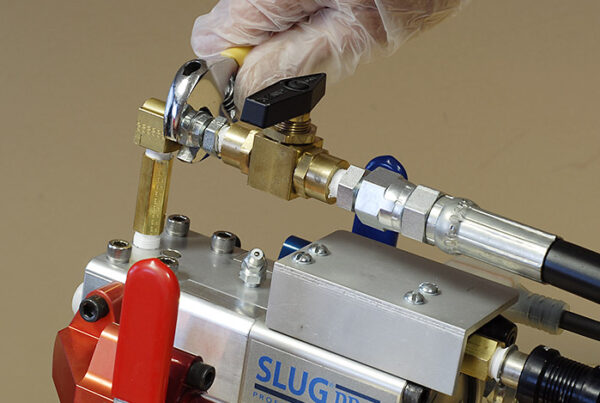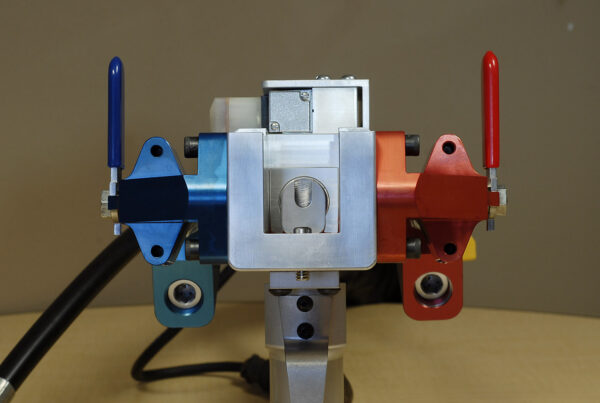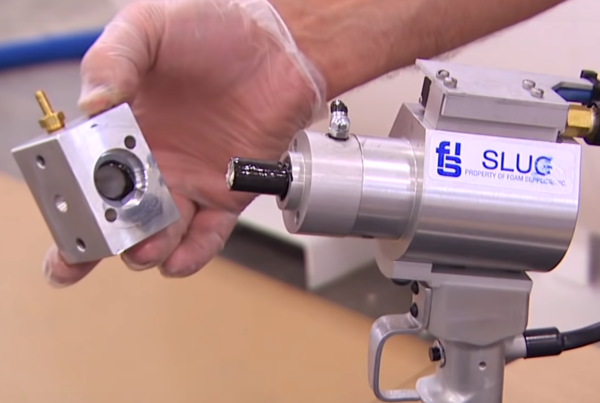Video Transcript
Welcome to another instructional video for FSI customers. This video will cover the procedures for connecting F6000 and similar large pressurized chemical cylinders, as well as the procedures for disconnecting cylinders, and preparing for return shipment.
Cylinder Components Overview
To start, let’s review the basic components found on the top of the cylinders and each of their functions.
First is the safety pressure relief valve, or PRV. The safety PRV is preset, and should not be tampered with. If the safety PRV pops, call FSI for assistance. Such an occurrence is rare.
Next is the chemical level gauge, which shows the chemical level in the cylinder. When the chemical level reaches five percent, you need to change the cylinder.
For pipe system users, change cylinders when the chemical level reaches ten percent.
The nitrogen inlet valve is where the nitrogen supply line is connected.
Next, are the chemical ball valves and Strat couplers. The Strat couplers can come in two sizes, 1 1/4″ , and 1/2″.
Last is the manual nitrogen pressure relief valve, used to manually relieve the nitrogen pressure prior to returning cylinders to FSI.
Pre-Connection Precautions
Before connecting cylinders, be sure to read and observe all labels and warnings listed on the cylinders.
Connecting Cylinders
Now, let’s review the procedures for connecting cylinders.
Start with the Isocyanate cylinder. Isocyanate, or ISO, is also referred to as the A side in the US.
Remove the protective cap and grease from the Strat coupler. Pack the grease and the protective cap so it can be reused when preparing the ISO cylinder for return. Be sure to remove all the grease from the Strat coupler, using rags and a small screwdriver are helpful with this step.
Spray the inside of the Strat coupler with DK 817 aerosol, and clean thoroughly with a rag. Removing the grease and cleaning the Strat coupler is an important step, and should be performed with care.
Next, lubricate the outside threads with lithium grease, or petroleum jelly.
Connect the female Strat coupler and tighten with a wrench.
FSI can supply specific Strat wrenches to make this step easier.
Nitrogen Connection and Cylinder Swap
Next, remove the yellow protective cap from the nitrogen inlet, and check the nitrogen snap tight fitting from the nitrogen supply line, to assure that the O-ring is intact.
If the O-ring is cut, worn, or damaged, it should be replaced. A damaged O-ring can lead to unnecessary nitrogen consumption, and failure to maintain operating pressure.
Once the reliability of the O-ring is confirmed, connect the snap tight fitting by pressing it into place.
Repeat the process for the POLYOL (or B-side) cylinder.
There is no grease on the POLYOL cylinder, as POLYOLS are self-lubricating. Just remove the plug, and connect the Strat coupler. Then, check the O-ring and attach the POLYOL side nitrogen snap tight fitting.
Preparing for Production
Now open the chemical and nitrogen ball valves, and perform the daily quality control procedures before beginning production.
Daily QC procedures are critical to assuring quality foam production, and should never be skipped. A separate FSI video is available to review these fast and simple procedures.
Disconnecting and Returning Cylinders
When the chemical cylinders near five percent of capacity, or ten percent for pipe systems, it is time to disconnect and return them to FSI.
Cylinders should always be disconnected before falling below the five or ten percent levels, to avoid drawing nitrogen into the dispensing equipment.
Disconnecting Steps
Just follow these simple steps.
First, close all chemical and nitrogen supply ball valves.
Disconnect the nitrogen supply line from the inlet valve, by pressing down on the top of the snap tight fitting, and pulling up on the flange near the bottom.
Reattach the yellow protective cap for transit.
Next, loosen and disconnect the ISO, (A) Strat coupler.
Wipe off all residual chemical from the coupler, and thoroughly rinse and clean with DK 817 aerosol.
Using the original grease stored in the protective cap, repack the Strat coupler opening and lubricate the threads.
Then screw on the protective cap and tighten.
Next, disconnect the POLYOL (B) cylinder.
Clean off any residual POLYOL from the Strat coupler, and connect the plug.
Blowdown Procedure
The final step, called blowdown, is done to reduce the pressure in the cylinders in accordance with Department of Transportation regulations.
The specific shipping pressure rating is designated on the hang tag on the nitrogen pressure relief valve.
This process can be very loud so we recommend doing it outdoors and with proper ear protection.
Once the cylinder is outside, or in a well-ventilated area, remove the yellow protective cap and open the nitrogen ball valve so the pressure can be monitored by the gauge.
Next, open the manual nitrogen pressure relief valve to reduce the pressure to the psi rating on the hang tag.
When the specified pressure is reached, close both the pressure relief valve, and nitrogen ball valve, and replace the yellow protective cap.
Returning Cylinders to FSI
Once the blowdown procedure for both cylinders is complete, they can be returned to FSI.
For your convenience, FSI includes a return Bill of Lading with each shipment. Look for a neon green sticker affixed to the cylinder for the appropriate return documentation.
If the Bill of Lading cannot be found, just call FSI and ask for the shipping department, and we will provide any necessary documents. If you have any questions at all about the procedures covered in this video, please call the FSI technical services department 1.800.325.4875. International customers call, +1 314.344.3330. We’re always ready to help our valued customers in any way we can.





